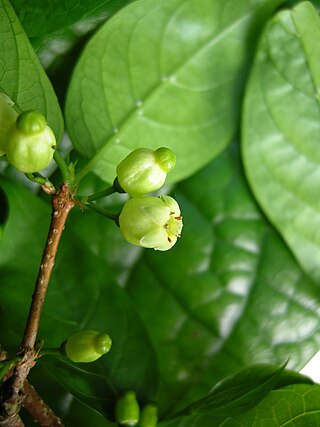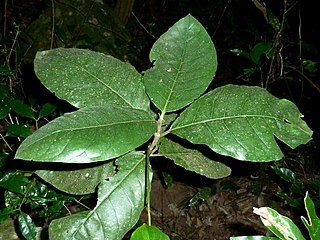
The Rubiaceae are a family of flowering plants, commonly known as the coffee, madder, or bedstraw family. It consists of terrestrial trees, shrubs, lianas, or herbs that are recognizable by simple, opposite leaves with interpetiolar stipules and sympetalous actinomorphic flowers. The family contains about 13,500 species in about 620 genera, which makes it the fourth-largest angiosperm family. Rubiaceae has a cosmopolitan distribution; however, the largest species diversity is concentrated in the tropics and subtropics. Economically important genera include Coffea, the source of coffee, Cinchona, the source of the antimalarial alkaloid quinine, ornamental cultivars, and historically some dye plants.
Keetia is a genus of flowering plants in the family Rubiaceae. It consists of climbers or scrambling shrubs, rarely small trees.
Multidentia is a genus of flowering plants in the family Rubiaceae.
Robynsia is a monotypic genus of flowering plants in the family Rubiaceae. It was described by John Hutchinson and was named after his friend and colleague Walter Robyns. The genus contains only one species, Robynsia glabrata, which is found in Ghana, Ivory Coast and Nigeria. The species is morphologically similar to the genus Cuviera but differs by having long, slender corolla tubes.

Rytigynia is a genus of flowering plants in the family Rubiaceae. It is found in tropical and southern Africa. The genera Rytigynia and Fadogia form a strongly supported clade but neither of these genera is monophyletic.
Temnocalyx is a monotypic genus of flowering plants in the family Rubiaceae. It was originally described by Walter Robyns in 1928 and contained five species. Since then most of these species have been made synonym and currently only one species name remains valid, i.e. Temnocalyx nodulosa. The species is endemic to southwestern Tanzania.

Vangueria is a genus of flowering plants in the family Rubiaceae. The genus is named for Voa vanguer, as V. madagascariensis is known in Malagasy.
Vangueriopsis is a genus of flowering plants in the family Rubiaceae.

Burchellia is a monotypic genus of flowering plants in the family Rubiaceae. The genus contains only one species, viz. Burchellia bubalina, which is endemic to southern Africa: the Cape Provinces, KwaZulu-Natal and the Northern Provinces in South Africa, and Eswatini. It is commonly known as wild pomegranate (English) or wildegranaat (Afrikaans).

Vanguerieae is a tribe of flowering plants in the family Rubiaceae and contains about 655 species in 30 genera. It is one of the most species-rich groups within the family and it is distributed across the Paleotropics.

Fadogia is a genus of flowering plants in the family Rubiaceae. The genera Rytigynia and Fadogia form a strongly supported clade but neither of these genera is monophyletic.
Hutchinsonia is a genus of flowering plants in the family Rubiaceae. It was described by Walter Robyns in 1928 and was named after his friend and colleague John Hutchinson. It is found in west tropical Africa.

Canthium armatum is a species of flowering plants in the family Rubiaceae. It is a shrub or tree native to southern Mozambique, Eswatini, and KwaZulu-Natal and the Northern Provinces of northeastern South Africa. The species is characterized by the presence of large spines.

Meyna is a genus of flowering plants in the family Rubiaceae.
Pygmaeothamnus is a monotypic genus of flowering plants in the family Rubiaceae. It was described by Walter Robyns in 1928 and originally held four species. It is found in central and southern Africa.
Fadogiella is a small genus of flowering plants in the family Rubiaceae. It was described by Walter Robyns in 1928.
Vangueriella is a genus of flowering plants in the family Rubiaceae. The genus is found in tropical Africa.

Vangueria bowkeri is a species of flowering plant in the family Rubiaceae. It is endemic to South Africa and Eswatini. It was described by Walter Robyns in 1928 and named after Colonel James Henry Bowker, the collector of the type specimen.










